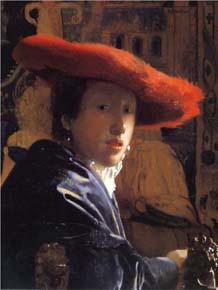

Throughout the 40 or so years that I have been painting, copying master works has held a certain fascination. It is a great way to practice and learn techniques from the very best. I copied Vermeer’s Girl in the Red Hat a number of years ago and gave it to Dave for his birthday. It was very unfair to actually buy the real one in the National Gallery, because that would deprive museum goers of the painting’s beauty, so I just decided to paint one of my own and leave the real one for others to enjoy.
One thing to keep in mind is unless you are right in front of the real painting; you are copying from a picture from a book or a slide. Most always, there is color distortion in the printing process, and it is not an accurate depiction. Nonetheless, it is enjoyable and beneficial to practice in this manner. You will notice here the fluctuation in the color range from print to print.
It would be presumptuous to say this one was easy to copy, but it was easy to manage because it is very small, measuring 9×7 or so. It is best to do your copy at the same scale as the original to avoid distortion of the shapes. Also, try to use the same substrate as the original, such as canvas, panel, or copper, which makes it more authentic. Here Vermeer used a panel, so I followed his suit.
Pigments are usually recognizable according to which period you are copying. History tells us that Vermeer used colors available at that time such as, flake white, lead tin yellow, and azurite, many of the earth colors, vermilion, among others. Historical pigments being right up my alley, I enjoyed guessing what colors he used where on the composition. The master often used lead tin yellow in place of white for highlights. This is especially noticeable here on the girl’s lips where it creates the illusion of moisture.
Have any of you done copies? What master do you like best?

I enjoyed you post and your painting on “girl in the red hat” . I like your approach with the use of historical pigments.
I have coped Klimt’s ” the kiss” , but a bit smaller at 60 x 60 for a Portland client and recently completed Manet’s “A Bar at the Folies-Bergère” for a London client. You are right, best to copy from the original, but it helps much if you have seen the original, and spent time studying it and other works by the master artist. Next one for me will be Madam X, an all time favorite of mine, which I find helps get me through the process. If you would ever like to see my copies, I would be happy to send you the images via email. Best Regards, JM Brodrick
Hello Jm, Love to hear that other artists copy the masters as a learning tool. Your choices are ambitious and challenging just for the mere size of them. Are you doing the Madam X as a commission piece also? I know that one is huge too! I would love to see what you have done. Send me some images via my email address. Best, Margret